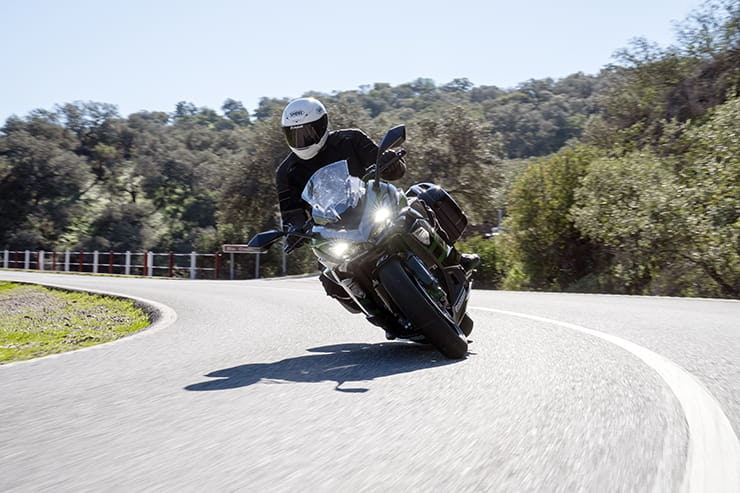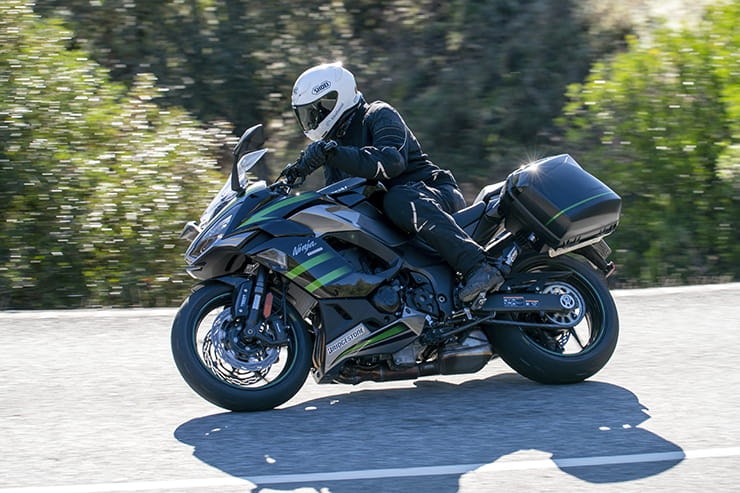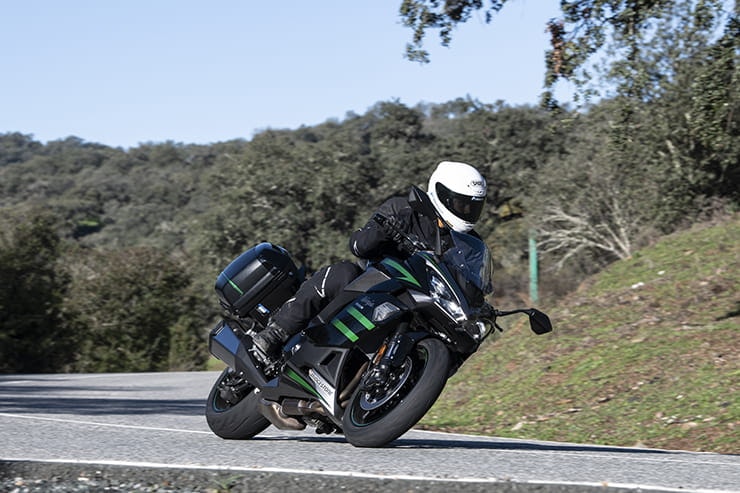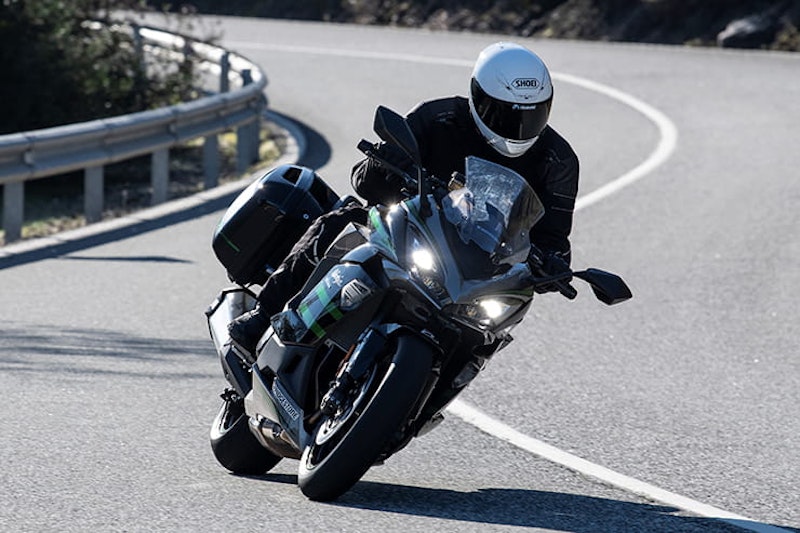Kawasaki Ninja 1000SX (2020) - Review
By Steve Rose
BikeSocial Publisher
07.02.2020
Kawasaki’s previous model Z1000SX – which started life as a faired version of the Z1000 super naked - always fell between the roles of sports tourer and roadgoing sports bike. Touring riders would suggest no bike with chain drive, a tiny screen and missing a centre stand could suit their needs while sporty riders were confused by the old bike’s clumsy low speed steering and pannier frames built like a climbing frame. None of which stopped the Z1000SX selling by the boatload (fifty per cent of all sports tourers sold in Europe were Z1000SXs in the last three years) because the competition was either not quite as well-equipped (Suzuki GSX1000F) or well-priced (Ducati Supersport and BMW R1200RS). For 2020 the Kawasaki has rationalised its European range to fit the rest of the world. If it has a full fairing it's a Ninja, naked bikes are ‘Z’ and if they aren’t quite sure it’s a Versys. So, the Z1000SX becomes the Ninja 1000SX with a smaller, lighter exhaust, TFT display, improved electronics, comfort and equipment and styling that resembles the other Ninjas. Oh, and a lean-angle sensor that displays maximum angle achieved on the dash. In no way is this going to end in tears.
Standard version costs £10,999, panniers are around £500 (tbc) extra
2020 Kawasaki Ninja 1000SX Price
List price is £10,999 for the standard model Ninja 1000SX. The Performance edition adds an Akropovič silencer, tinted screen, frame sliders, seat cowl and tank pad for an additional £1000. You can also buy a touring edition, which has a taller screen, pannier set (with inner bags) heated grips and sat-nav mount and also costs £1000 extra. Or you can have the Performance Tourer edition containing all the above for an extra £2000 (£12,999). The standard model’s price is £1200 less than Ducati’s Supersport and £1400 cheaper than BMW’s most basic model R1250RS and even the fully loaded Ninja 1000SX Performance Tourer is still very good value. Kawasaki’s 6.3% APR PCP deal means with £1000 deposit you’ll pay £169.70 per month for 37 months for the standard bike. Suzuki’s GSX-1000F currently has £1000 off its £10,499 list price and with the same deposit will cost £127 per month. On paper the two bikes share a lot, but the Kawasaki has an awful lot more 21st century electronics than the talented-but-basic Suzuki.
Yamaha’s Tracer 900GT costs £200 more than the Ninja but comes with panniers and heated grips as standard, although its electronics aren’t quite as sophisticated as those on the Kawasaki.
Smooth power, plenty of it and am I the only person who thinks four cylinders sound twice as good as two?
2020 Kawasaki Ninja 1000SX Power and torque
140bhp doesn’t sound as impressive in 2020 as it did 20 years ago when fire breathing superbikes made similar amounts. But it’s still as powerful as Honda’s not-exactly-slow CBR1100XX Blackbird and much more impressive than BMW’s R1250RS. The point here is that the latest fuel injection and ignition technology means that every single one of those horses is delivered as effectively as possible whether you are bumbling along through town or chasing a pack of hungry journalists down a twisty Spanish road with free lunch at the end of it. And that’s before you consider that the Ninja’s chassis, suspension, tyres and electronics let it corner faster and more safely than any noughties race replica.
Riding a modern inline four-cylinder engine after a few too many ‘characterful’ twins is an absolute delight. So smooth, so creamy, such easy power delivery – it’s no wonder the Japanese came in and did for the old British, Italian and German manufacturers overnight in the 1970s. I love the feeling of sitting at 5000rpm in top gear knowing that there’s instant and precisely-delivered drive available for overtaking at the twitch of your right wrist.
What a four-cylinder engine might lack in character, it makes up for in flexibility. Press launch routes tend to be chosen for the quota of blind-hairpins-per-mile, which is great for the first ten minutes, but tedious (for me, anyway) after that. Having a motor that can do 70 miles of single-track roads climbing up and down hillsides, pulling from 1500rpm to 8000rpm in third gear with no glitches or burps in the delivery makes for a very relaxing ride and lets the rider put all available brain space into reading the road. That’s handy on a press launch, but even more so at the end of a long week on the road, cruising through Europe on rain-soaked mountain passes with a grumpy pillion on the back. Twins? you can keep em.
Up/down quickshifter is new for 2020, enormous exhaust collector prevents a centre stand being fitted
Engine, gearbox and exhaust
Water-cooled, fuel-injected four cylinder, with a six-speed gearbox. The same basic engine is also used in the Versys 1000, but the Ninja makes 20bhp more. On the surface not much has changed for 2020, but Kawasaki’s engineers have been busy making it Euro-5 ready. Somehow, they’ve managed to get all the emissions equipment into an exhaust with only one end can too (which saves 2kg), while keeping the claimed power and torque figures essentially the same as the old model.
The riding modes are now all linked to the 6-axis inertial measurement unit (IMU) that controls the lean-angle sensitive ABS and traction control. And a change to ride-by-wire electronically controlled throttle valves means that cruise control can also be fitted. If you’re one of those who still thinks that cruise control is unnecessary on a motorcycle, you’ve probably not had as many speeding tickets from average speed cameras in road works as the BikeSocial editorial team. Trust us, we love cruise control.
The new bike has both a slipper clutch to make changing down at high engine speeds a little smoother and an assisted clutch for less slip under hard acceleration. The new design needs only three clutch springs instead of the six on the previous bike, which Kawasaki claims gives a lighter feel at the lever. I couldn’t feel the extra lightness, but the clutch and gearchange action is really easy anyway
An up-and-down quickshifter now comes as standard and it’s a really neat installation that reflects how much better put-together modern Kawasakis are than their predecessors. Like most quick shifters it takes a few miles acclimatise and work out where it is good and when a conventional shift is better. At low revs in a high gear it will be clunky, especially on downshifts, but in the upper parts of the rev range the quickshifter works really well.
In-town riding is easy (helped by mirrors that return to their original position after filtering)
2020 Kawasaki Ninja 1000SX Economy
One of the biggest benefits to the rider of recent emissions law changes has been that bikes have generally got much more economical. Press launch riding is not like normal riding. Lots of stop-starts for photo shoots and video, roads that are constantly on or off the throttle meaning lots of gas-guzzling acceleration as you chase the pack to keep up. Our test route was about 150 miles, the average speed at the end of the day was only 60km/h (which gives an indication of just how tight and twisty most of the riding was) and the bikes all seemed to average between 45-49mpg, giving a tank range of around 200 miles. That’s not great for a sporty all-rounder in 2020, but I suspect it’ll be better under real world riding conditions.
Kawasaki Ninja 1000 SX (2020) Review
Kawasaki’s road-going sports bike inherits the Ninja title, gets a TFT display, improved traction control, ABS and comfort. Join BikeSocial's Steve Rose as he shares his thoughts from the European Launch in Córdoba, Spain
49 degrees of lean looks like this. Bridgestone’s S22 tyres and subtle chassis improvements make the Ninja 1000SX a sharp handler.
Handling, suspension, chassis and weight
Frame and suspension are basically the same as the previous model, with some subtle revisions to the fully adjustable front forks’ damping cartridges to reduce pressure build-up during compression giving a smoother fork action over bumps. The steering head angle is slightly sharper and trail has been reduced by 4mm. Which doesn’t sound much, but, in combination with a change of tyres to a specially developed Bridgestone S22, the new bike steers very differently to the old one. Gone is the low-speed clumsiness and heavy steering, replaced by something that just feels like an easily controllable motorcycle at any speed. In conjunction with the equally easy riding position and room for legs to not be too cramped, the Ninja is a very confident bike through long, sweeping corners, tight and challenging off-camber blind hairpins and those horrible gravelly mountain-pass switchbacks where you can’t help but comfort-brake (Rossi and co call it trail braking, which is much more heroic), but still have the confidence on this bike to make it round.
It’s a really impressive chassis that would embarrass a lot of proper track-focused sports bikes on the kind of roads we like to ride.
The rear shock retains the remote preload adjuster – handy on a bike where you might be riding with a pillion and need to swap settings easily.
State of the art calipers upfront, what looks like a 1980s GPz750 tribute on the back. Cornering ABS is refined for 2020
2020 Kawasaki Ninja 1000SX Brakes
Front calipers are the same monobloc items as before and discs are the same diameter, but no longer of petal design. The rear unit looks like the one on my old 1984 GPz750 Unitrak, making it probably the longest-surviving component in motorcycling. Lean-angle sensitive ABS is linked to the new six-axis IMU controller. On a couple of occasions I found the rear ABS would pulse gently as I braked hard into another off-camber hairpin, but not so it affected the stopping power significantly and the front brakes (allied to the suspension performance that lets you use them) are superb.
Rider and pillion seats are wider and better padded, cruise control is now standard, screen could be better and adjustment makes little difference
Comfort over distance and touring
The redesigned screen sits at a more upright angle and is adjustable through four positions. It is reasonably effective at taking the wind off your chest but the four different angles don’t make a huge difference (the screen doesn’t rise and fall, just change angle) and at high speed I had too much windblast going onto my face and neck.
Two seats are available; the standard ‘comfort’ seat is 835mm high and wider than before with more padding, while the optional ‘middle’ seat, available as an accessory takes 15mm off the seat height and makes it easier to get your feet on the ground if your legs are shorter than you’d like. Our bikes had the comfort seat fitted and, on the 150-mile test ride it lived up to the name. Just as importantly for a bike with sporting ambition, the foot pegs are high enough to give ground clearance, but still offer enough room for six-footer comfort.
Don’t take this for granted – it’s easier than you’d think to get this wrong – BMW’s R1250RS and Ducat’s Supersport both being a good case in point.
Simple clocks have plenty of information and optional displays. Lean angle measurement entertains your inner-teen
Rider aids and extra equipment / accessories
The TFT dash has enough available functions to please the geekiest rider and is easy to use. The most discussed will be a display that shows lean angle achieved. On our test ride we were hitting between 45 and 52 degrees, but one of the Spanish journos got to 54 degrees. Meaningless, of course, but it won’t stop you looking at it.
Much more useful is the latest version of Kawasaki’s lean-sensitive traction control and ABS. There are three preset rider modes and two user settings. Road and Sport mode have full power and sharp throttle response, but different levels of TC interference. Rain mode cuts the power and brings the TC in earlier. Kawasaki’s TC system works predictively rather reactively and mostly you don’t even know it’s kicking in.
Also new this year is cruise control. Simple to use and easily disengaged by squeezing the throttle shut to an extra degree as well as the usual methods.
The biggest downside to the previous model remains though - the new Ninja still can’t officially run with panniers and a top box. You run either-or but not both, because there is a concern that when riding fully flat-out, it can cause instability.
BMW’s R1250 RS can run both (although it doesn’t go as fast as the Ninja) and you do wonder whether Kawasaki would have been better restricting the Ninja’s top speed a little and allowing the luggage flexibility. I guess it depends at what speed the instability occurs, but Kawasaki’s own Versys 1000 which does 135mph flat-out is allowed the full three-box package and I doubt many Ninja owners will do more than that other than in the pub.
It’s a state-of-the-art 21st century sports bike for people who want most-but-not-all of the bells and whistles, a little more versatility and value-for-money too.
2020 Kawasaki Ninja 1000SX verdict
Launch reports always come with an asterisk because the riding environment and roads chosen are designed to make the experience as enjoyable as possible and riding a bike like this in 20-degree Spanish sunshine on deserted twisty roads was the kind of relief to a British winter that would have made a 40 year-old Honda CX500 feel great.
But asterisks aside, this is clearly a very good bike. It has plenty of power, impeccable fuelling and ease-of use and a chassis that copes as well with demanding switchbacks as it does with fast sweepers and finally steers like we knew it could, while being very comfortable too. It has most of the required 2020 electronic gizmos plus dangle-ometer for the geeks.
Suzuki’s GSX1000F can now only compete on price and while BMW’s R1250 RS has shaft drive, more luggage options and better fuel economy, it is also a lot more expensive and less comfortable.
Three things I loved about the 2020 Kawasaki Ninja 1000SX…
engine and chassis flexibility and capability
good value
comfort
Three things that I didn’t…
needs a taller screen
And a centre stand
can’t use a top box and panniers together
2020 Kawasaki Ninja 1000SX spec
Looking for motorbike insurance? Get a quote for this bike with Bennetts motorcycle insurance



